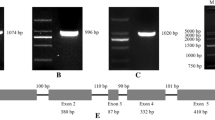Abstract
The rice genome encodes three different isoforms of two pore potassium channels (TPKs). Recently, the characteristics and features of some rice TPK channels (OsTPKa and OsTPKb) were reported. In order to further evaluate the functional features of these channels, two of the three rice isoforms and one Arabidopsis isoform (AtTPK1) were cloned and expressed in the mutant E. coli strain—LB2003. The E coli LB2003 strain lacks K+ uptake systems and thus is incapable of growing on low external K+ concentrations. The expression of channels in bacteria was confirmed by RT-PCR. Our results show that expression of these channels in the bacterial mutant restored the LB2003 growth on low K+ media. The analysis of potassium uptake exhibited elevated levels of K+ uptake in the three types of TPK transformants. Our data suggest that these plant vacuolar channels can form functional potassium transport systems in bacterial cells.
Similar content being viewed by others
References
Isaenkov, S.V., Plant vacuoles: physiological roles and mechanisms of vacuolar sorting and vesicular trafficking, Cytol. Genet., 2014, vol. 48, no. 2, pp. 127–137.
Isaenkov, S.V., Transport systems of tonoplast of plant vacuoles and their potential applications in biotechnology, Biotechnol. Acta, 2013, vol. 3, pp. 9–22.
Isayenkov, S., Isner, J.C., and Maathuis, F.J., Membrane localization diversity of TPK channels and their physiological role, Plant Signal. Behav., 2011, vol. 6, pp. 1201–1204.
Dunkel, M., Latz, A., Schumacher, K., et al., Targeting of vacuolar membrane localized members of the TPK channel family, Mol. Plant, 2008, vol. 1, pp. 938–949.
Gobert, A., Isayenkov, S., Voelker, C., et al., The two-pore channel TPK1 gene encodes the vacuolar K+ conductance and plays a role in K+ homeostasis, Proc. Natl. Acad. Sci. U.S.A., 2007, vol. 104, pp. 10726–10731.
Voelker, C., Schmidt, D., Mueller-Roeber, B., and Czempinski, K., Members of the Arabidopsis AtTPK/KCO family form homomeric vacuolar channels in planta, Plant J., 2006, vol. 48, pp. 296–306.
Bihler, H., Eing, C., Hebeisen, S., et al., ATPK1 is a vacuolar ion channel different from the slow-vacuolar cation channel, Plant Physiol., 2005, vol. 139, pp. 417–424.
Latz, A., Becker, D., Hekman, M., et al., TPK1, a Ca(2)-regulated Arabidopsis vacuole two-pore K channel is activated by 14-3-3 proteins, Plant J., 2007, vol. 52, pp. 449–459.
Hamamoto, S., Marui, J., Matsuoka, K., et al., Characterization of a tobacco TPK-type K channel as a novel tonoplast K channel using yeast tonoplasts, J. Biol. Chem., 2008, vol. 283, pp. 1911–1920.
Becker, D., Geiger, D., Dunkel, M., et al., AtTPK4, an Arabidopsis tandem-pore K channel, poised to control the pollen membrane voltage in a pH- and Ca2+-dependent manner, Proc. Natl. Acad. Sci. U.S.A., 2004, vol. 101, pp. 15621–15626.
Carraretto, L., Formentin, E., Teardo, E., et al., Thylakoid-located two-pore K channel controls photosynthetic light utilization in plants, Science, 2013, vol. 342, p. 114–118.
Isayenkov, S., Isner, J.C., and Maathuis, F.J.M., Rice two-pore K channels are expressed in different types of vacuoles, Plant Cell, 2011, vol. 23, pp. 756–768.
Schlösser, A., Meldorf, M., Stumpe, S., et al., TrkH and its homolog, TrkG, determine the specificity and kinetics of cation transport by the Trk system of Escherichia coli, J. Bacteriol., 1995, vol. 177, pp. 1908–1910.
Uozumi, N., Nakamura, T., Schroeder, J.I., and Muto, S., Determination of transmembrane topology of an inward-rectifying potassium channel from Arabidopsis thaliana based on functional expression in Escherichia coli, Proc. Natl. Acad. Sci. U.S.A., 1998, vol. 95, pp. 9773–9778.
Isayenkov, S. and Maathuis, F.J.M., Arabidopsis thaliana vacuolar TPK channels form functional K uptake pathways in Escherichia coli, Plant Signal. Behav., 2013, vol. 8, p. e24665.
Kim, J.E., Kwak, J.M., Uozumi, N., and Schroeder, J.I., AtKUP1: an Arabidopsis gene encoding high-affinity potassium transport activity, Plant Cell, 1998, vol. 10, pp. 51–62.
Uozumi, N., Kim, J.E., Rubio, F., et al., The Arabidopsis HKT1 gene homolog mediates inward Na currents in Xenopus laevis oocytes and Na uptake in Saccharomyces cerevisiae, Plant Physiol., 2000, vol. 122, p. 1249–1259.
Author information
Authors and Affiliations
Corresponding author
Additional information
Original Ukrainian Text © S.V. Isayenkov, F.J.M. Maathuis, 2015, published in Tsitologiya i Genetika, 2015, Vol. 49, No. 1, pp. 3–9.
About this article
Cite this article
Isayenkov, S.V., Maathuis, F.J.M. The expression of rice vacuolar TPK channels genes restores potassium uptake in E. coli mutant strain LB2003. Cytol. Genet. 49, 1–5 (2015). https://doi.org/10.3103/S0095452715010053
Received:
Published:
Issue Date:
DOI: https://doi.org/10.3103/S0095452715010053



